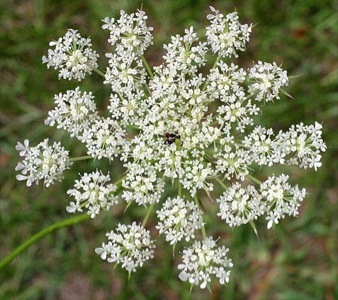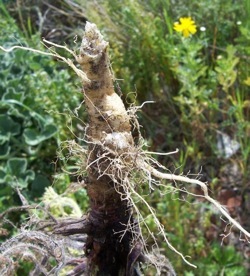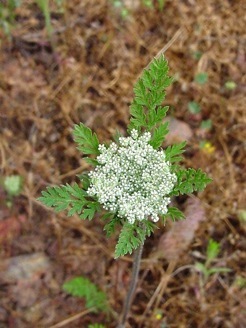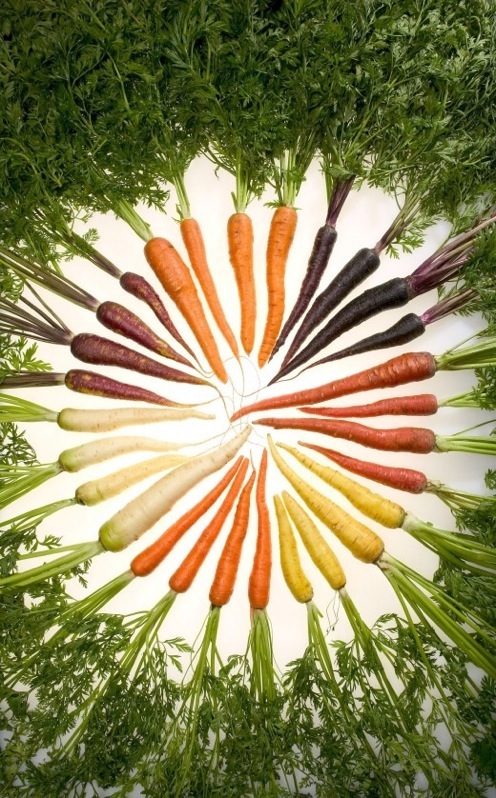Daucus Carota & Pusillus: Edible Wild Carrots
I’ve never understood the confusion over identifying the Wild Carrot also called Queen Anne’s Lace: It has a flat white blossom with a red spot in the middle, hairy stems and stalk, and the white root that smells like carrot. As the blossom ages it folds up looking like a bird’s nest. That seems quite easy to me, and was when I was a kid. Wild carrots were a common pasture plant. I tried eating more than one root raw, along with some dirt. The key is to find them at the end of their first year before the roots grow woody their second year. However, often that woody part can be peeled off and the root made edible.
As straight forward as it seems some experts say the Wild Carrot only occasionally has a red flower in the middle. Really? I’ve never saw one without it when I was younger. That said, the above description is for the Daucus carota (DAW-kus ka-ROT-a) a wild carrot imported from the Old World and known everywhere in the United States as “Queen Anne’s Lace.” But, there was a native carrot in North America when the Pilgrims arrived, the Daucus pusillus (DAW-kus pew-SILL-us.) It does not have a red dot.
D. pusillus is found in the southern half of the United States and up the west coast to British columbia. Much smaller than the D. carota, its root are none the less edible, though that is not saying much. It tends to have flowers that are white to pink and white, again no red dot. Like the import, the stems are hairy. The hairy stems and stalk is a very important identification element and separates the two carrots from very deadly members of the same family, such as Poison Hemlock which has a hairless stalk.
The Daucus carota is loosing some of its luster. A majority of states (at least 35 of them) list it as a pest or a noxious weed. It is particularly bad in Missouri. Apparently D. carota germinates easily and mowing doesn’t get rid of it. Some say the dried seed heads are a fire hazard and a threat to the honey industry. Another flower of the field demonized. My advice: Eat The Weeds! (See recipe on bottom)
Daucus pusillus, also called the American Wild Carrot and Rattlesnake Weed (I think nearly everything has been called Rattlesnake Weed) is a simple to few-branched annual that grows to three feet tall but usually less. The stems are covered with stiff hairs. The leaves are alternate, pinnate and compound on stems to six inches long. The umbrella-arranged flowers have five white petals and five stamens. It has fewer florets per cluster than the D. carota, 5 to 12, instead of 20. It likes dry ground, rocky to sandy soil, oak forests. Blooming time is April to June. The roots are similar to the D. carota, just smaller.
Unlike many native plants there’s not much evidence most Native Americans made much use of the D. pusillus. Eastern tribes ignored it, perhaps, records on them are scant. Only six western Indians seem to have used it. The Nez Perce and Navajo ate the roots, boiled or raw. They also used it to ‘clean the blood,’ stop itching, treat fevers and treat snake bite. A decoction and or a chewed poultice was used to treat snake bite. The Clallam, Cowichan, Saanich and coastal Salish also ate the root.
One way to get a steady source of good wild carrot roots is to grow them yourself. They sprout readily. Collect the seeds in the fall and set them out in the spring. Under cultivation they grow large, tender roots. The root of Queen Anne’s Lace is likely a direct ancestor of the modern carrot which has been under cultivation for some 5,000 years, probably starting in Afghanistan. While the wild carrot root is cream colored to light orange there are a number of varieties including white, yellow, red, purple, green, black, striped and purple on the outside and orange inside. The orange carrot is believed to have been developed in the 16th century in Holland, where patriotic plant breeders developed it to celebrated the Royal House of Orange.
Incidentally, that cultivated carrot you bought or grew? The green tops are quite edible cooked. Add them to a variety of boiled dishes for flavor, or boil them separately and add them to other dishes as greenery.
The name Queen Anne’s Lace was adopted because Queen Anne of Great Britain was adept at making lace. They carried the allusion farther by saying the red flower in the middle is when she pricked her finger and a drop of royal blood fell on the flower.
Daucus is from the Greek word THAV-kon) meaning carrot parsnip and other similar food plants. Carota is from the Greek ka-ROW-ton, also meaning carrot is from the Indo European word Ker, meaning head or horn. Pusillus is Latin for tiny or puny.
Daucus plants can make cattle and horses “nervous.” The toxicity is consider mild.
Queen Anne’s Lace Jelly
18 Large Queen Anne’s lace heads
4 Cups water
1/4 Cup lemon juice (fresh or bottled)
1 Package powdered pectin
3 2/3 Cups
Bring water to boil. Remove from heat. Add flower heads (push them down into the water). Cover and steep 30 minutes. Strain.
Measure 3 Cups liquid into 4-6 quart pan. Add lemon juice and pectin. Bring to a rolling boil stirring constantly. Add sugar and stir constantly. Cook and stir until mixture comes to a rolling boil. Boil one minute longer, then remove from heat.
Skim. Pour into jars leaving 1/4″ head space. Process in hot water bath for 5 minutes. Makes about 6 jars.
Green Deane’s “Itemized” Plant Profile
IDENTIFICATION: Daucus carota: An erect, biennial herb; leaves basal and alternate, two-pinnately divided with narrow segments; flowers small, white, in a terminal, umbrella-shaped cluster; 20 florets, often with red spot in middle; seed small, dry, ribbed, with bristly hairs. Roots smell of carrots.
TIME OF YEAR: Roots in fall, blossoms in season
ENVIRONMENT: Full sun to partial shade, fields, pastures, meadows, rocky soil even clay.
METHOD OF PREPARATION: Roots cooked or if you have good teeth, raw. Thin and stringy. The flower clusters can be french-fried for a carrot-flavored gourmet’s treat. Aromatic seeds good for flavoring soups and stews. Dried roasted roots can be are ground into a powder and used as a coffee substitute.






When I was a girl, I’d pick wild flowers for my mom here in Ohio. Usually Queen Ann’s Lace was in the mix, and more than half were all white, without the red in the middle.
Iroquois Medical Botany by James W. Herrick. Page 195. Wild Carrot/ Queen Anne’s Lace. Tons of Eastern tribes eat it and use it medicinally. Thought you should know
In Peace and Beauty…Aho
Ah, but that book apparently was referring to the imported Queen Anne’s Lace aka wild carrot of the old world, Dacus carota, NOT the native ‘wild carrot’, Dacus pusillus.
Or is it? And so the confusion continues…
Does Queen Ann’s lace get the little stickers on the head when the flower dries in the fall?
Hmmmm… depends on what you mean as stickers. Some folks say it looks like a bird’s nest.
This is a follow up to an old post I found researching what some here call beggar’s lice.
There is a variant of the wild carrot we have all over here in Texas that can be found in association with Queen Anne’s Lace or mostly on it’s own. It can be invasive. In trying to find out more about this plant I found a lot of confusing references so I am posting here to see if some botanical experts can set the record straight. threads to terms like sticktight or stickseed refer to plants in no way resemble what I am referring to. The crushed leaves and root smell like carrot so I am sure it is of the wild carrot family. The flower resembles Queen Anne’s Lace and the stem is sort of hairy not smooth like hemlock is supposed to be.
The main difference is that after flowering, the flowers turn into little burrs that are very annoying and stick to clothing, gloves, almost anything and are especially annoying when I walk my dog and he gets them embedded in his fur or halter. Queen Anne’s Lace does not do this to my knowledge and experience as my grandmother grew Queen Anne’s Lace on our homestead many moons ago.
Some detailed info on this would be appreciated as there is nothing on the web about this particular variant.
Regards
Daucus pusillus makes little burrs after flowering. http://w3.biosci.utexas.edu/prc/HaysFlora/pages/DAPU3.html
Those are the seeds
Just be wary – (supposedly) some people are very sensitive to sunlight after touching carrot plants. The chemicals responsible are called furocoumarins are at least in parsnip and giant hogweed. I’m not 100% sure on Queen Anne’s Lace as I’ve never grown it, yet.
Have you seen or heard of any poison hemlock growing in South Florida? I have not but wonder about it. I look for hairy stems anyway.
Poison hemlock tends to grow in northwest Florida, where as water hemlock makes it way down the peninsula.
Hi. I have plants in my yard that are either Daucus carota or Daucus pusillus. Is there any way to tell which they are before they have flowered? Are both considered invasive or just one? I want to know if I should let them stay or not. I think they are beautiful green and when they flower, but I don’t want them taking over. Thanks!
Sarah
They have to flower before they seed. You can wait for the blossom then ID them and remove the ones you don’t want.
When I grow carrots in my garden I always leave some in the ground at harvest just so I can enjoy the flowers when they go to seed.
My daughter and I grow them for the butterflies. Queen Anne’s Lace is also a host plant for Black Eastern Swallowtail caterpillars:)
Can the leaves and stem be eaten? Wondering if the entire plant is edible.
The stems and leaves are either too tough of too strong tasting to eat. Not a nice texture.
I make pesto out of finely chopped wild carrot tops. It’s quite nice.
They taste good to me! Although, I’m a cow.
I just plucked, rinsed, chopped small with a scissors the leaves of several plants I picked. The root (the plants were flowering) are just too tough. I boiled the root over 30 minutes and have to chew the good stuff out and throw the rest away. Back to the leaves I cooked them for 30 minutes then added lambs quarters, zucchini, yellow squash, chopped garlic, chopped leeks, can chili peppers and canned tomatoes (from Aldi) and spaghetti sauce and simmered it another hour or 2. It tasted great and nothing was chewy. From now on I will skip the root and cook the greens. I planted a bunch of root in my yard and threw the flowers around. Hopefully it grows here now. I don’t know the plant well enough to harvest it yet before it flowers.
Never forget about Water Hemlock. It’s an attractive plant with greenish-white umbels and carrot-like roots and is VERY poisonous. Don’t taste it!
Queen Ann’s lace looks remarkably like cow bane, a very toxic plant
also known as water hemlock and wild parsnip.
The native wild carrot, Daca pusilus, and the imported wild carrot aka Queen Anne’s Lace, or Daca carota, could have been growing together.
One also wonders about the possibility of natural hybridization occurring between the two plants…
It’s very easy to identify Queen Anne’s Lace from Hemlocks. I live in Missouri, and the Lace grows anywhere that isn’t mowed regularly. Backyards, forests (sometimes), roadsides, etc. If one umbel doesn’t have a red dot, then check the other 5-50 umbels! And if the plant only has a few umbels, then it’s probably not worth digging up.
When I was young in Michigan an old man told me many times to get a wild carrot and break off the stem, and carefully using the juice apply it to a wart. And I think he said it would be gone in three days.
I have a lot of love for these plants, for personal reasons as well as what they offer to the wildlife. My primary interest in Daucus carota developed after I read a forum discussion between various women discussing herbal birth control and contraceptive methods.
It was said that the mature seeds, if eaten in 1Tablespoon doses (this measurement is of uncrushed seeds) by the female very shortly after sex and every 12 hours thereafter for 3 days would prevent pregnancy by what was likely interruption of the body’s synthesis of progesterone (apparently needed in order for a fertilized egg to implant itself within the uterus). The seeds MUST be crushed up to release their volatile oils, either by chewing or some other method, or they won’t do you any good. I personally recommend using a spice grinder for it, because the taste and texture is, as someone else put so well, akin to chewing on “Vic’s vapor rub-flavored razor stubble” and chewing takes some time to thoroughly crush them up.
Enough humans have been using this as a contraceptive for numerous centuries that this use has been written about in ancient days. Based on its long standing history of use and the fact that its simply the wild ancestor of today’s typical cultivated carrot I chose to try this method. I used it as my sole method of contraception for a couple years until I moved from the area where I was able to gather large quantities of the seed in the Autumn. It worked flawlessly for me. As with anything I recommend doing your own research before using ANYTHING for this purpose, but if anyone comes here wondering about this use I can confirm it performed as claimed for myself, specifically following that timing I mentioned above. I love this plant for how easy and reliable it is to prevent unwanted pregnancies while getting to still enjoy the acts of sex with a partner, without the awful sensation ruiner that is the condom.
When I was a kid, 70 or so years ago, my mother told me women used Wild Carrot to prevent pregnancy. The details were not conveyed.
I don’t know if this is the same carrot. I had a crop of normal carrots and many went to seed in the summer. I didn’t bother and then I found them growing like weeds. But their carrots better than the original crop,they self propogated in dry sandy soil and taste great. Not sure if their wild carrots or just a f2 hybrid or something. But I got hundreds of them,seem like proper carrots just grew themself
Wild carrots found there way here ( daucus) according to ( App. Picture this ). Are the tops edible and do they have the nutritional value of other greens? Help
I think they are too tough and strong flavored… unlike commercial carrots.
Thanks for the info, Deane.
Is there any sugar in the Queen Anne’s Lace jelly? Is that the 3-2/3 cup reference?
Thanks for the info, Deane.
Is there any sugar in the Queen Anne’s Lace jelly? Is that what the 3-2/3 cup refers to?
Was gathering info re wild carrots n found much more info
I live in Montana,wild carrots aren’t extremely abundant but they are present. They are fabulous for luring in bees to pollinate. I Also have heard about the contraceptive possibilities. They very pretty flowers that shouldn’t be tagged as noxious weeds.